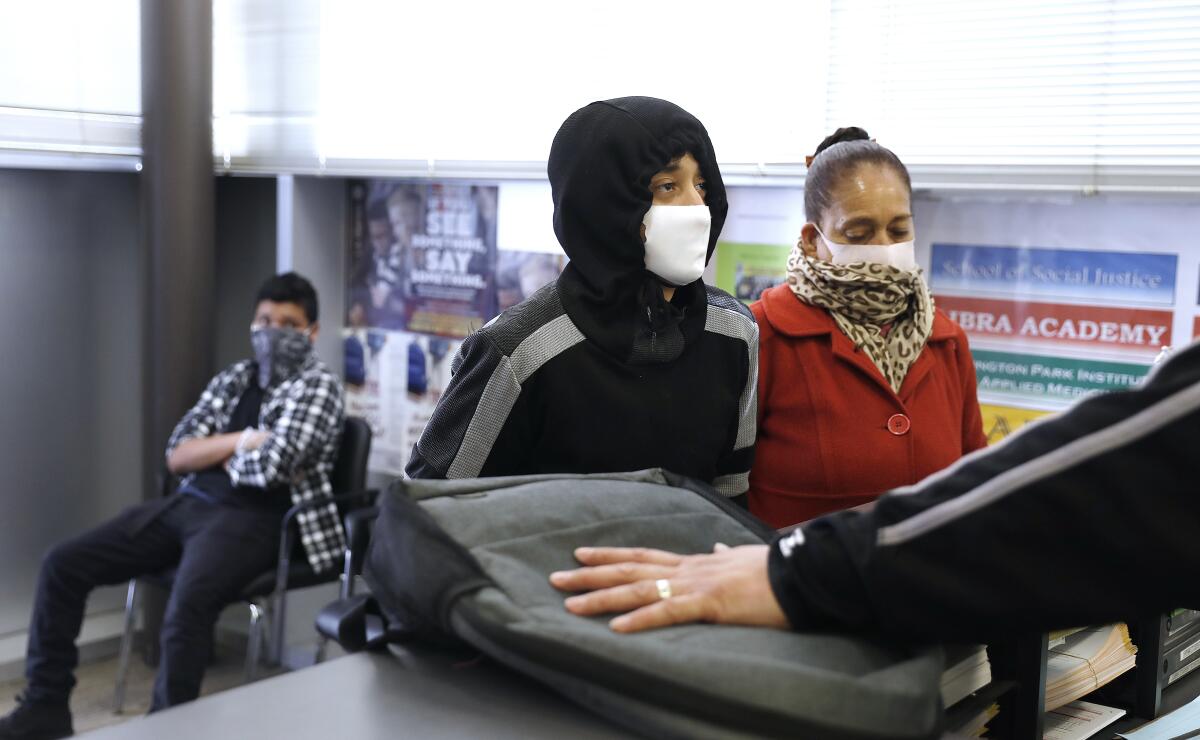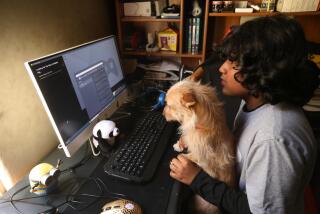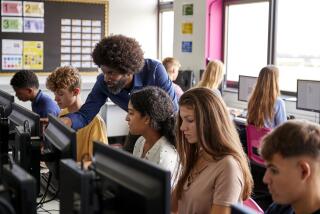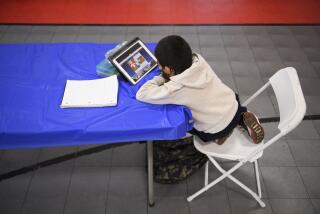Students are in ‘desperate need’ of computers amid coronavirus distance learning

As the school year slips away, state officials are far behind in a race to provide students the computers and broadband they need to continue learning that was interrupted by campus shutdowns due to the coronavirus pandemic.
Although Monday brought some good news from Gov. Gavin Newsom — that 70,000 computers and 100,000 hot spots have been pledged to date — those figures fall well short of the state’s tally estimating that over 400,000 more computers and hot spots are needed.
About 200,000 additional households with students are without computers or hot spots. That figure is based on information assembled by the California Department of Education.
Other officials and experts as well as other surveys peg the need much higher. First Partner Jennifer Siebel Newsom on Monday cited estimates that as many as one in five of California’s more than 6 million K-12 students — perhaps 1.2 million — lack either connectivity or an appropriate device for remote instruction.
The state estimates don’t necessarily count school systems, including L.A. Unified, that hope to be reimbursed after recently dipping into reserves or spending at an unsustainable pace to buy computers and hot spots.
The need is staggering, said Linda Darling-Hammond, president of the state Board of Education.
“It’s a desperate need now, it will continue to be a very intensive need,” Darling-Hammond said. The same communities of color who need to connect their children to their teachers are also experiencing higher rates of infection and mortality, she added, and can’t connect to tele-health services or apply online for benefits and jobs or order groceries online to avoid the risks of going out.
“The connectivity issue is really a survival issue for families as well as an issue for the education of their kids.”
In one survey conducted earlier this month by the California School Boards Assn., 39% of school districts reported that less than half of students have laptops courtesy of a school or a school partner. And 50% said that less than half their students have more than one device with internet access at home — a problem when multiple students or adults need the family computer at the same time.
The association said about a third of the state’s school systems took part.
In L.A. County, access both to devices and the internet before the pandemic correlated with income and race, according to a report from USC based on estimates from the 2018 American Community Survey.
Among the poorest fifth of households, only about half had a desktop or a laptop and subscribed to residential broadband. This compares to about nine in 10 families in the top 20% of earners. And “regardless of income,” black and Latino students were less likely than others to have the technology they need to learn digitally, according to the analysis.
In announcing a wave of philanthropy Monday as well as corporate donations and discounts, Newsom also acknowledged the shortfall.
“We continue to need to do much, much more,” Newsom said. “We’re not done. This is the beginning of a process.”
For the briefing on schools, Newsom brought forward Siebel Newsom, who cited recent surveys indicating that 50% of low-income families and 42% of families of color are worried about distance learning for their children because they don’t have a device at home.
“The fear these parents have that their children will fall behind without internet access and devices is very real,” said Siebel Newsom. She added, “We have your back and will continue to fight for you.”
Also speaking at the governor’s daily coronavirus briefing was state Supt. of Public Instruction Tony Thurmond, who has convened a task force to address the digital divide.
“Our digital divide has gone on longer than this pandemic,” Thurmond said. “It is something that has gone on for decades.”
The current situation presents an imperative to close that gap “once and for all,” he said.
The encouraging words from state officials did not placate fears about limited resources among school districts.
“A lot of focus has been placed on the need for distance learning and we completely agree that that’s appropriate,” said Troy Flint, a spokesman for the California School Boards Assn. “But what deserves equal attention is whether schools have the resources to do distance learning effectively. The answer to that is no.
“We need to accelerate even beyond what they’ve done in this very short period of time,” Flint said. He added that the state is making progress.
The state’s campuses shut down abruptly in early to mid-March, with little time to plan what or how to switch to distance learning. While the state has provided academic guidance, it’s provided few material resources. Schools that waited for the state or federal government to pay for computers and broadband are largely still waiting as the end to the traditional academic year approaches.
Sacramento Unified is experimenting with turning seven school buses into mobile Wi-Fi hot spots, hoping literally to roll out the initiative by May 1. Newsom hailed that approach as promising — as something that, if it works, other school systems could begin to emulate.
But the state already is about seven weeks into the campus closures.
Los Angeles Unified authorized spending $100 million for computers and hot spots, but had to purchase higher-priced devices because adequate, less-expensive devices were not available. Hot spots were not immediately available to many families either, despite the district’s willingness to pay for them.
L.A. Unified also faced other challenges: After two weeks, 15,000 high school students, about 12.5%, had not yet logged on, percentages that have since improved. On Monday, the number of disconnected high school students had dropped to 3,000, the district said.
Additional concerns persist. About 7% of high school students still are not connecting electronically with their teachers every week. And verifying learning is more complex than tracking who has logged on and for how long, said L.A. schools Supt. Austin Beutner.
Among the donors highlighted Monday by Newsom were Google, Microsoft, Lenovo, HP, Sprint, T-Mobile, Zoom and Apple, along with individuals including internet entrepreneur Jack Dorsey and foundations including the Chan Zuckerberg Initiative.
Newsom also announced that the California Public Utilities Commission will make $30 million available to help school districts provide hot spots and computers.
More to Read
Sign up for Essential California
The most important California stories and recommendations in your inbox every morning.
You may occasionally receive promotional content from the Los Angeles Times.













